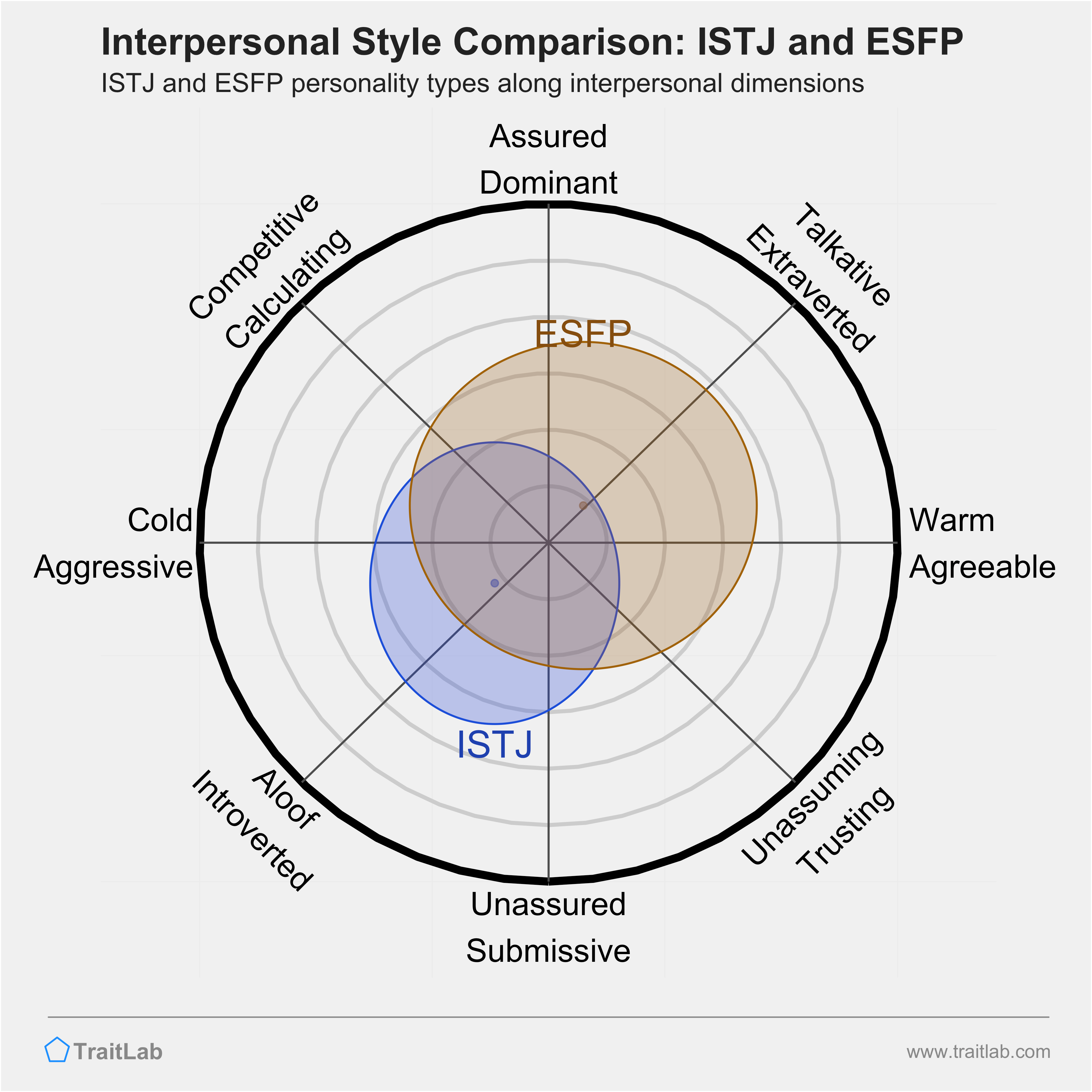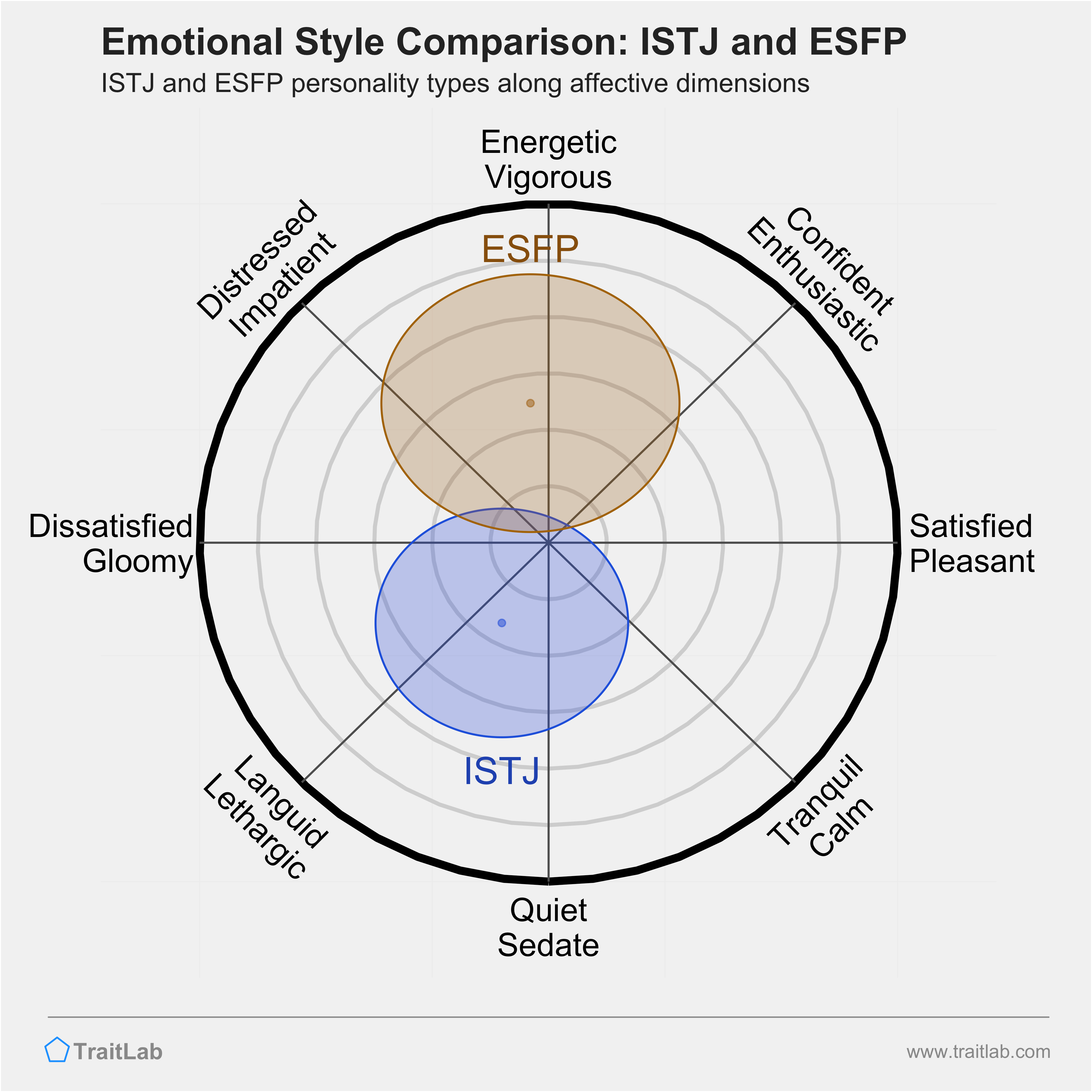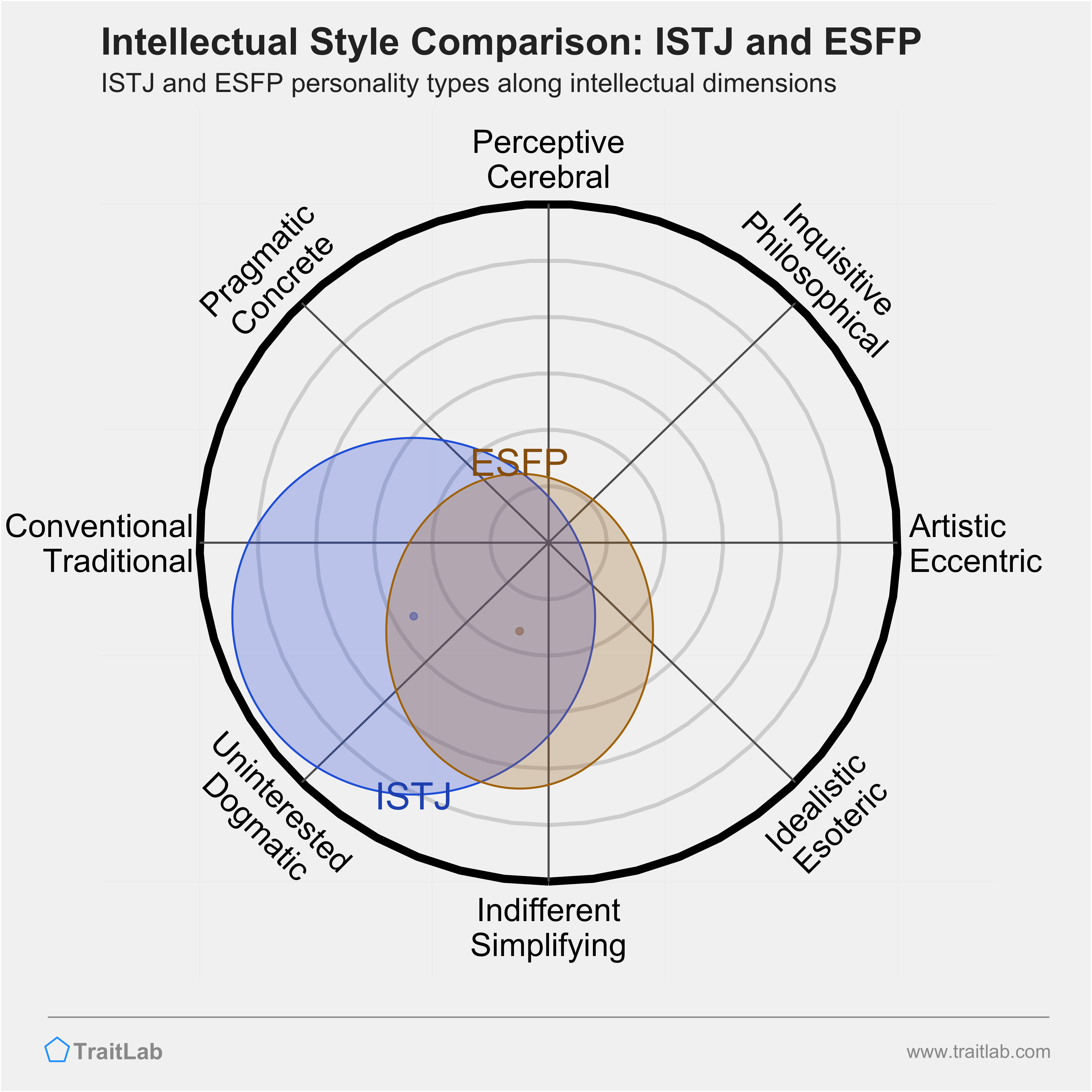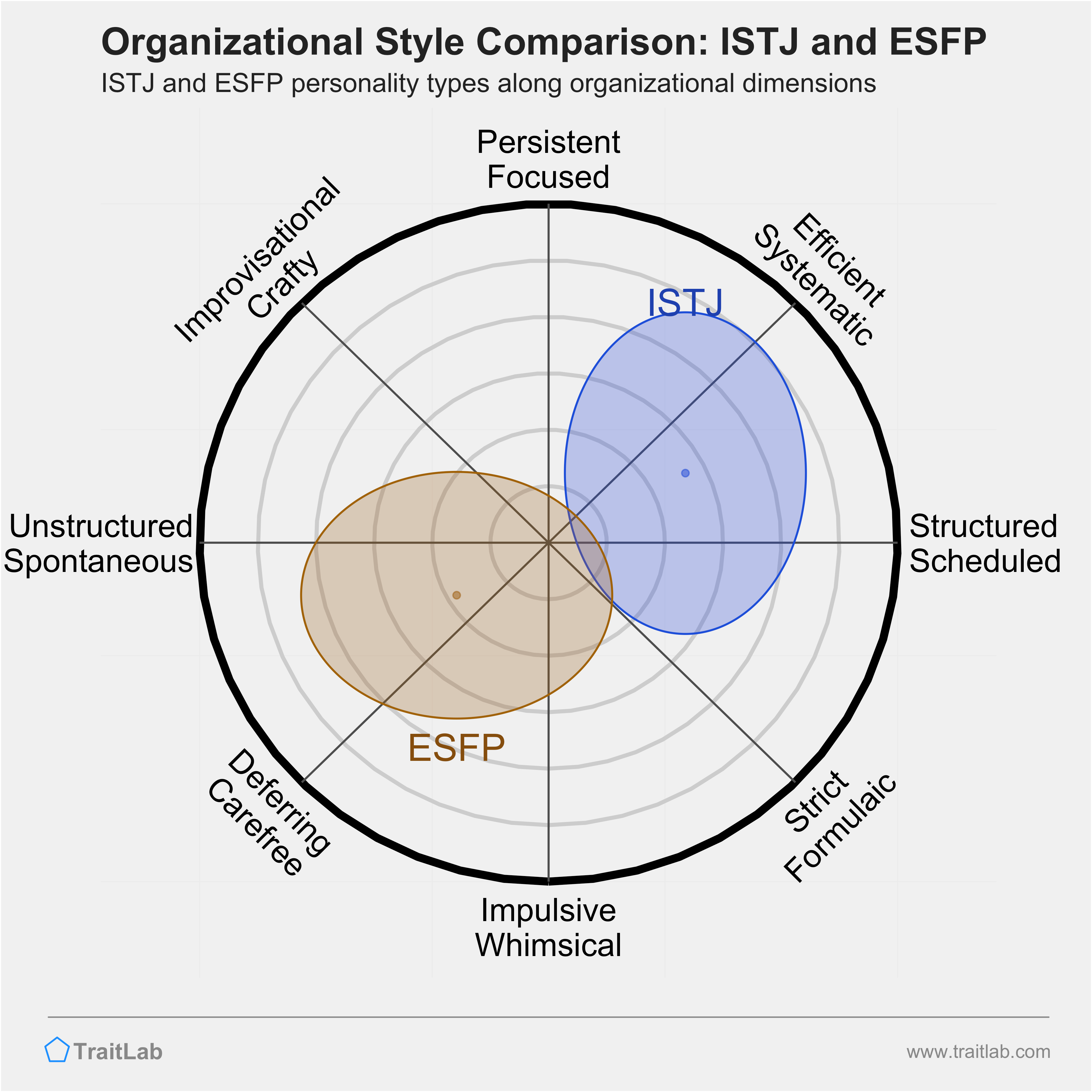How compatible are ISTJ and ESFP patterns of communicating, thinking, and working?
Reading time: 5 minutes

Gregory Park, Ph.D.
Author
In this article, you’ll find a comparison of ISTJs and ESFPs across five important personality domains: Interpersonal/Communication Style, Emotional Style, Intellectual Style, and Organizational Style.
One important note: the following comparisons cannot be made simply by comparing the cognitive functions (letters) of each personality type.
For this analysis, TraitLab gathered data about personality traits from thousands of participants who identified themselves as a particular type in the 16 Personality or Myers-Briggs framework.
The comparisons here show the average similarities and differences between ISTJs and ESFPs. However, remember that all personality types are oversimplifications. For an assessment of your unique position in these areas, you’ll need a personalized assessment that doesn’t rely on personality types.
Jump to any section with the links below.

Do you know your personality type?
Learn about your type and so much more with TraitLab's comprehensive personality assessment.
Your particular style of communicating and interacting with others can be described fairly well by two dimensions: assertiveness and warmth.
Assertiveness describes your tendency to assert yourself, lead, and influence others in social situations, while warmth describes your tendencies to empathize and put others’ needs ahead of your own.
People with the same personality type often share some similarities in assertiveness and warmth. In the graph below, you can see where most ISTJs and most ESFPs fall along both of these dimensions.
First, take a look at where people in each type, on average, fall in this interpersonal space.

ISTJs are realists who perceive things and people clearly, without being overly optimistic. At their best, they are practical skeptics who are comfortable holding and sharing unorthodox, unpopular views. ISTJs may be overly skeptical and suspicious, and they may have difficulty trusting others. At their worst, they can struggle to make new friends and socialize, and have a hard time showing affection and admiration for others.
ESFPs often support, openly sympathize, and actively offer help to others At their best, they are gentle sympathizers, who are easily trusted and accepted. ESFPs may be overly revealing and have difficulty being alone. At their worst, they can require too much attention and admiration from others and be excessively involved in the affairs of others.
As an ISTJ, one notable difference between you and most ESFPs is in your interpersonal warmth. You are likely on the colder, more combative side of the spectrum. Compared to you and other ISTJs, ESFPs’ can sometimes feel overly focused on feelings and intentions, rather than the facts of the matter at hand.
Another important difference between you and most ESFPs is in your relative assertiveness or passivity in social situations. Like many ISTJs, you are often on the more passive, reserved side of the spectrum. In some cases, this is a perfect compliment to ESFPs’ more dominant, assertive style, and the two of you can make an effective team. However, you may find that you need to put extra effort into making your opinions heard when working with ESFPs.
Another characteristic of your personality is your emotional style — your tendencies towards different kinds of moods. There are two dimensions that influence emotional style: arousal and valence.
Arousal describes your relative energy level across different situations. Those with high baseline levels of arousal tend to be generally more alert, active, and engaged, while those with a lower baseline are more reserved, subdued, and inhibited.
Valence describes whether these moods tend to be positive (pleasant) or negative (unpleasant). People with a more positively valenced style are more likely to experience emotions like joy, enthusiasm, satisfaction, and serenity. People with a more negatively valenced style are more likely to experience sadness, frustration, dissatisfaction, and anxiety.
The graph below shows where each type, on average, usually sits in this emotional space.

ISTJs have a tendency to be quiet and inhibited. Compared to most people, they can easily drift into gloom and melancholy. They see the glass as half-empty and have a more skeptical outlook and a hesitant approach to life. For better or worse, ISTJs tend to notice the negatives in most situations. In stressful times, they are more likely to withdraw quietly and retreat inward, rather than share their frustration with others.
ESFPs tend to be tense, concerned, and vigilant in many situations. They usually have a pessimistic outlook and are often looking for what could go wrong next. ESFPs are highly active and tend to juggle many tasks. When things go wrong, this energy can turn into frustration and impatience, and they are more likely to express their dissatisfaction to others.
As with most ISTJs, you tend to be more reserved, inhibited, and quiet than most ESFPs. Between the two of you, you are more likely to need more personal space, solitude, and time to decompress. While you can tolerate long periods of calm and quiet, your ESFP counterparts often craves more engagement and excitement. In the best cases, an ESFP can pull you out of your comfort zone and get you out into the world, while your quiet nature helps to balance out their intensity.
However, ISTJs and ESFPs often default to the negative side of the emotional spectrum. While you may not always express them, you are both more likely to experience negative emotions like sadness, worry, frustration, and impatience. It’s rare to find ISTJs or ESFPs in a bubbly, cheerful mood. Like most people, they have moments of joy and satisfaction, but these dissipate quickly. They often point out the negatives in most situations and have a more pessimistic outlook.
Your intellectual style describes how you receive, process, and pursue different kinds of information. Differences in intellectual style are captured well by two dimensions: ideas and aesthetics.
Ideas describes your appetite for new information and your interest in complex, challenging material. People high on the ideas dimension have an appreciation for complexity and technical details. People lower on ideas are less interested in learning for learning’s sake, and they prefer to simplify complex topics down to the essential details.
Aesthetics captures your relative interest and sensitivity to aesthetic information and its emotional impact. People higher on the aesthetics dimension usually have strong artistic interests and a deep appreciation for beauty in many forms. Those lower on aesthetics tend to value practical application over artistic merit and usually adhere to more conventional standards of beauty.
In the graph below, you’ll see where ISTJs and ESFPs, on average, fall in this intellectual space.

Most ISTJs and ESFPs overlap heavily in their intellectual style.
ISTJs and ESFPs are practical realists. They focus on building practical skills and essential knowledge and are less likely to spend time learning for learning’s sake. In addition, they usually value conventional, tangible accomplishments over artistic expression and rarely feel compelled to develop a creative outlet.
As an ISTJ, you and most ESFPs are down-to-earth, straightforward thinkers. You’d both prefer to stick to the essentials and focus on practical issues, and you try to avoid overcomplicating matters. When you and your ESFP counterpart are together, your conversations are more likely to revolve around concrete details, facts, and conventional topics rather than theoretical or philosophical ones.
Likewise, ISTJs and ESFPs share an appreciation for practical, tangible accomplishments over artistic expression. ISTJs and ESFPs are both likely to embrace conventional ways of thinking, and both types are more skeptical of eccentric or unusual approaches to solving problems.
Your organizational style describes your habits around organization and planning. Your organizational style influences how you structure your time and physical space. Differences in organizational style fall along two dimensions: industriousness and orderliness.
Industriousness describes your persistence, need for achievement, and intensity of focus. People higher on industriousness usually organize their behavior around a few important long-term goals. People lower on industriousness are usually more focused on the present and will more easily change their focus when new opportunities appear.
Orderliness describes your need for regularity, order, and structure in your environment. People higher on orderliness prefer tidy, organized physical spaces, detailed schedules, and reliable routines. People lower on orderliness can tolerate more disorganization and prefer a more spontaneous, unstructured approach.
The graph below shows the average position of ISTJs and ESFPs along these dimensions of organizational style.

ISTJs are usually systematic and highly organized. They like setting big, long-term goals and then creating detailed plans to accomplish them. ISTJs are generally good at ignoring distractions and making steady progress through consistent routines and habits.
ESFPs thrive in unstructured environments with fewer constraints and more room for improvisation and serendipity. They generally focus on enjoying the present rather than preparing for the future. ESFPs highly value spontaneity and the flexibility to change their mind, and they resist setting hard deadlines or rigid expectations.
As with most ISTJs, you and many ESFPs can clash over your need to set goals and use time efficiently. While you have an easier time getting down to work and staying focused, your ESFP counterpart may be more easily distracted and unpredictable. Working consistently with a narrow focus often comes naturally to many ISTJs like you, but you may find that ESFPs benefit from additional structure to keep them on track. While you enjoy planning and tend to mind the future, your ESFP counterpart helps you enjoy the present, injecting some much-needed spontaneity into your schedule.
A second difference between ISTJs and ESFPs is in their relative need for order, structure, and regularity. While you and most ISTJs thrive on well-defined systems and consistent organization, your ESFP counterpart often feels overly constrained and bogged down by too much structure. They are more comfortable with chaos and are happy to take life as it comes, whereas you try to create order, routine, and predictability. Your differences in tidiness, punctuality, and compliance with social expectations may occasionally create conflict, too.
Most people have complex personalities and don’t fall into a single personality type.
With TraitLab’s comprehensive analyses of your traits, strengths, and interests, you can see how your personality compares to all 16 types. Start building your personality profile by creating a free account today.
For comparisons between ISTJs and other types from the 16 Personality typology, visit any of the type pairings below:
For comparisons between ISTJs and other Enneagram types, visit any of the type pairings below: